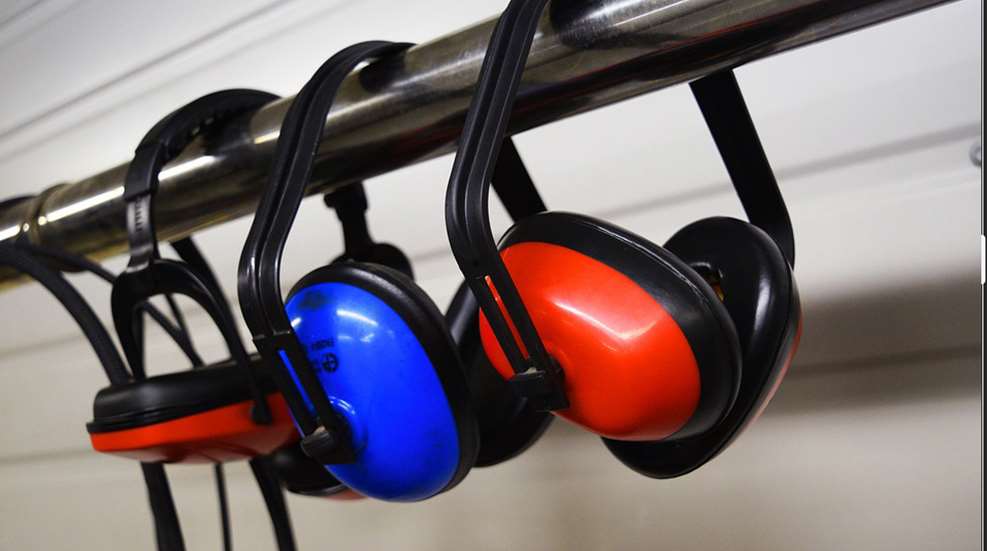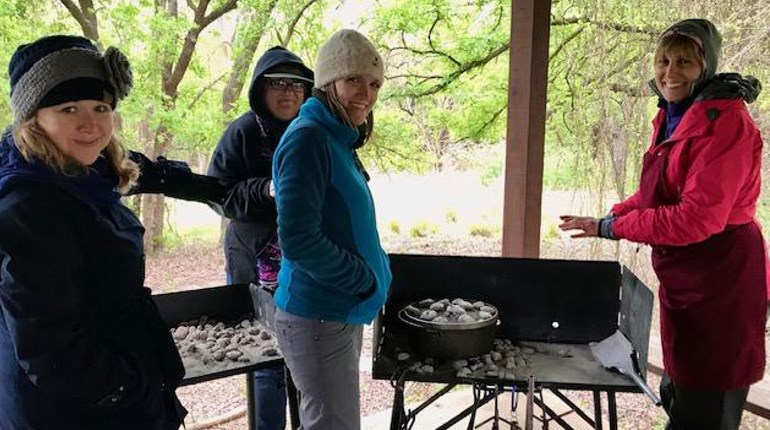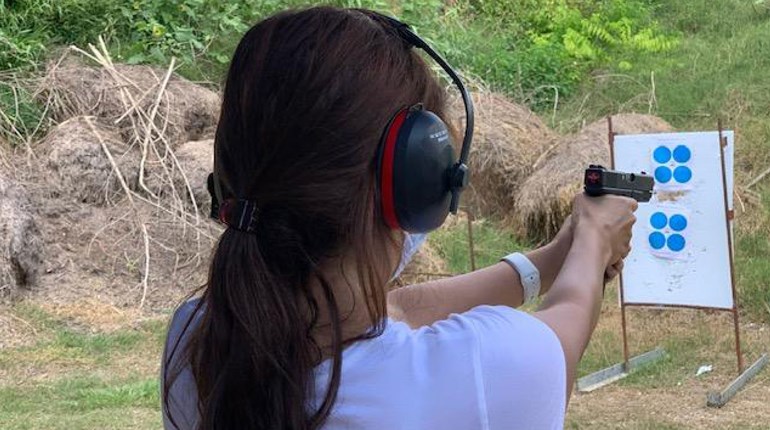
Knowing what these terms mean can keep everyone safe while having an enjoyable experience at the range.
Accidental Discharge—An unanticipated and unforeseen discharge of a firearm. Injuries and property damages can possibly be prevented if all shooters follow the number one rule of firearm safety: ALWAYS keep the muzzle pointed in a safe direction
Baffle (Safety Baffle)—A structure used to restrict bullets once they are fired, keeping them in a smaller confined area than would otherwise be impossible to contain without the use of baffles. Safety baffles are designed to stop a bullet if a shooter raises his or her muzzle and points over their intended target. Baffles are designed so that the shooter, regardless of the shooting position allowed on the range, cannot see any sky or ceiling above the structure. Safety baffles may be overhead, on the ground, on top of the backstop, in the roof of the firing line cover, or any other design to successfully restrict the sight picture of the target and funnel the bullets to the target area.
Ballistics—The science or study of the motion of projectiles that are shot and move through the air. Internal ballistics are what happens inside of a firearm when discharged. External ballistics is the study of the flight path of a projectile. Terminal ballistics is the study of what the projectile does upon impact.
Backstop—Anything that will safely stop a bullet and prevent it from hitting anything else after the target is struck. The backstop provides the primary impact area for the bullets being fired on a range and, under normal conditions, prevents the bullet form leaving the range area.
Benchrest—A benchrest is usually a flat, steady table or surface, used by a shooter to sit behind and steady him or herself for accuracy, prior to discharging their firearm.
Benchrest Shooting—The object of benchrest shooting is to place 5 or 10 shots through the same hole on the target within a fixed time limit. All shooting is done from an artificially supported shooting position. It is the pinnacle of accuracy and precision in shooting sports.
Berm—At outdoor ranges, a berm is a mound of earth, dirt, or concrete embankment or a wall constructed to restrict bullets to a given area, which serves as a backstop.
Bipod—A two-legged support that can be attached to the front end of a rifle, or a separate device that the rifle is rested upon, to stabilize the gun while shooting.
Cartridge—The ammunition for a rifle or handgun, comprised of a case, primer, powder, and bullet
Cease Fire—This is the only command that can be called by anyone, anytime, and anywhere when something unsafe is happening or about to. When the command “Cease Fire” is given, all shooters freeze in place, keeping the muzzle pointed downrange and keeping their finger off the trigger, awaiting instructions from the Range Safety Officer (RSO). Under normal shooting conditions the RSO will frequently call a Cease Fire when it is time to change targets.
Cold Range—Firearms are to be unloaded with the action opened, and depending on the range rules, may require the bolt to be removed and/or unloaded firearms placed in the rack. No one is allowed to handle their firearm or ammunition during a cold range. This command is given when it is time to change targets.
Down Range—The area of a gun range, where firearms are pointed towards the target when they are fired.
Dry Fire—Squeezing or pulling the trigger on an unloaded firearm. Dry firing drops the hammer on an empty chamber and is a method of practicing your shooting fundamentals while improving form and technique. When dry firing, remember to always treat unloaded firearms as if they were loaded. A lot of shooters use “snap caps,” which are replicas of live rounds but will not discharge, while practicing the dry fire technique.
Dud—A round of ammunition that does not fire; something that does not do what it is supposed to do.
Ear Protection—A piece of safety equipment used to protect shooters and spectators’ hearing. Ear, or hearing, protection is required on a shooting range and highly recommended anytime you shoot a firearm. Foam ear buds fit inside the ear canal. Earmuffs completely cover both ears externally and are usually connected by a headband. Electronically enhanced devices are fitted with internal speakers and external microphones. When a loud sound occurs, the speakers deactivate to cancel the loud sound to protect your hearing and reactivate back to “normal” when noise reaches a safe level again.
Elevation—The setting on the sights of a firearm’s scope or iron sights that controls the vertical placement: the way to move the bullet impact up or down at the target.
Eye Protection—Safety glasses or other protection for the eyes. Eye protection should always be worn at shooting ranges and highly recommended anytime you shoot a firearm.
Firing Line—This is where the actual live firing occurs. Ammunition is loaded into the firearm, the firearm is pointed down range in a safe direction, and the shooter fires the firearm at the target. Hearing and eye protection should always be worn while on the firing line.
Hangfire—Occurs when the primer of the round is struck by the firing pin, but there is a delay before the powder is ignited. It can take anywhere from a fraction of a second to a couple seconds for pressure to build enough to force the round down the barrel. It is extremely important to keep the firearm pointed down range and in a safe direction for at least 30 seconds before attempting to eject the round.
Holster—A sheath-like carrying case for a firearm, worn on a belt, in a shoulder sling, or a scabbard saddle. A holster serves to protect the gun's mechanisms and finish, to provide security by covering the trigger so it cannot be pulled unintentionally, and to present the grip of the gun at a constant angle for easy access.
Hot Range—When “The Range is Hot” or “Hot Range” is called, shooters may pick up their firearms keeping them pointed in a safe direction, load and resume firing.
Minute-of-Angle (MOA)—This is an angular measurement of how scope adjustments are made. A MOA is 1/60th of a degree. 1 MOA spreads about 1" per 100 yards. (Actually 1.047"). Every scope is different; consult your owner’s manual for your scope’s adjustment increments.
Misfire—A firearm that fails to fire, or fails to discharge ammunition properly. Treat a misfire like a hangfire, keeping your firearm pointed down range and in a safe direction for at least 30 seconds before attempting to eject the round.
Muzzle—The open end of the barrel where the projectile exits.
Muzzle Blast—The high temperature and high-pressure gases that are expelled from the muzzle of a firearm.
Muzzle Brake—A device attached to the end of the barrel of a firearm that reduces recoil. It redirects some of the pressurized gas that propels the bullet out the muzzle, to the sides and possibly backwards, from the bullet’s direction of travel.
Muzzle Control—Being aware of and responsible for which direction your firearm is pointed at all times, and ALWAYS keeping the firearm and muzzle it pointed in a safe direction.
Muzzle Flash—The visible light or fire produced by the muzzle blast.
Muzzle Velocity—The speed of a projectile, usually expressed in feet or meters per second, as it leaves the muzzle of a gun.
Ready Area—This is the preparation area before shooting occurs. There is no live firing; no dry firing; no loading or unloading, and no handling of firearms in this area.
Reactive Targets—Targets that react when you hit them, such as fall over, burst, send up smoke, make noise, or some other instant reward when hit.
Recoil—Oftentimes called “kick,” it is the rearward momentum of a gun when it is fired.
Shell—The ammunition for a shotgun, comprised of a case, primer, powder, wad, and shot.
Skeet—A shotgun sport that has a high house and a low house, throwing targets at different angles on a field with 8 different shooting stations, arranged in a semi-circle. A round of skeet consists of 25 targets.
Spectator Area—This is an area well behind the Ready Area, where no firearms or ammunition is present, and no live firing occurs.
Sporting Clays—A shotgun sport that combines elements of skeet and trap, and is designed to simulate field and hunting conditions. A full sporting clays course consists of 50 to 100 targets, depending on the number of stations.
Squib (Squib Load)—A round of ammunition that goes off when the hammer strikes the primer, but does not generate the normal amount of pressure, resulting in either the bullet failing to exit the barrel or fails to travel the normal range or distance as that particular round should.
Stovepipe—Failure of a spent ammunition case to completely eject from a semi- automatic or a pump action firearm. The case usually stands on end while stuck in the ejection port instead of being thrown clear after the shot, resembling a stovepipe or a smokestack.
Target Line—A line parallel to the firing line along which targets are placed. The target line is always down range.
Trajectory—The arc produced by a projectile traveling from the muzzle to the point of impact.
Trap—A shotgun sport that has five stations which the shooter faces toward the trap house, which is in the center of the field. The trap machine randomly rotates and throws clay birds, presenting the shooter with a variety of going-away shots at different angles and elevations. A round of trap consists of 25 targets.
Windage—The setting on the sights of a firearm’s scope or iron sights that controls the horizontal placement: the way to move the bullet impact left or right at the target.
Zero—A firearm is said to be "zeroed in" when the sights have been adjusted so that the bullet will hit the center of the target when the sights are properly aligned upon the center of the target; the shooter is hitting exactly where they are aiming.














































